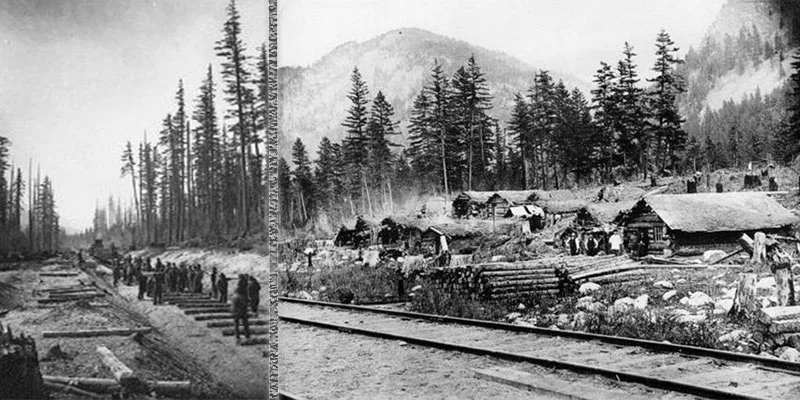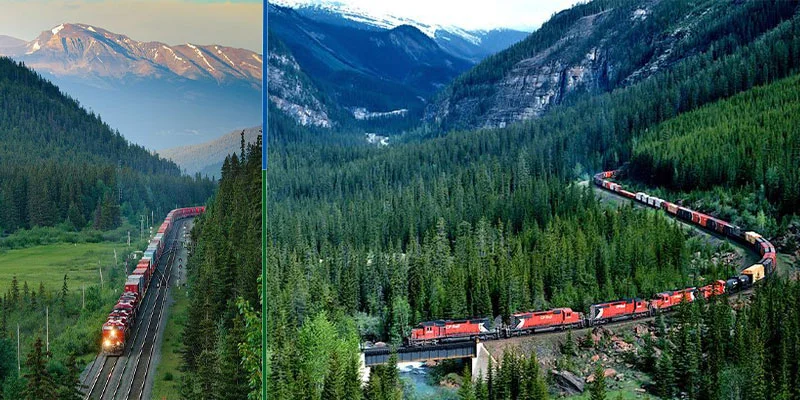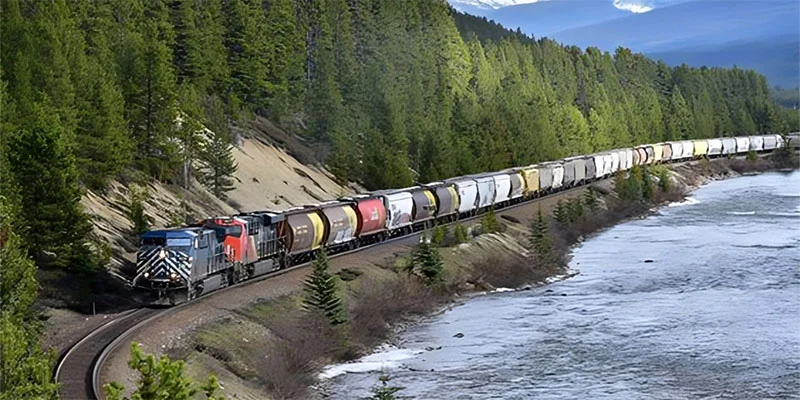- Elnaz Navidi Mjd
- information
- 819 views
- 0 comments
The Canadian Pacific Railway (CP) is a powerful symbol of Canadian unity and development. Stretching from the Atlantic to the Pacific, it is more than just a means of transportation; it became the lifeline for the nation's growth. This monumental project, built in the late 1800s, combines distant communities and various countries in countries that contribute to economic growth. SLR has promoted a cross-Canada, which is essential for forming national political, social, and cultural fabrics. This article explores the history of the Canadian Pacific region, the challenges it has overcome, and its lasting impact on Canada.
Table Of Content

Historical Background of the Canadian Pacific Railway
The Canadian Pacific Railway was conceived in the late 19th century to fulfill a promise made during British Columbia's entry into Confederation. Its development was driven by the need to connect Canada's vast regions and secure economic and political unity، "and among these advancements:
- Confederation and the Need for a Railway
The Canadian Pacific Railway's construction was essential for Canada's formation in 1867. One of the most significant issues in a new country was that it combined vast land from the Atlantic to the Pacific Ocean. British Columbia agreed to join Canada in 1871, mainly because of the need for a railway to connect it to the rest of the country. The Canadian government understood that a reliable transportation system was vital to the country's survival. Without this, distant areas will fight trade, communication, and management, complicing the country's detention. The construction of a railway passing through Canada's vast and solid zone -with a mountain, forest, and open pasture- was a monumental challenge.
Cyrus Crafts; Luxury & Unique Products
- Initial Efforts and Challenges
In the early 1870s, the Canadian government began planning a railway. Sir John A. Macdonald, Canada's first prime minister, was a big supporter of this idea. He thought a national railway was necessary for the economy and to help keep the country together. But there were many challenges, like political arguments, money issues, and tough engineering problems. The first attempt to build the railway was troubled by scandal. In 1873, a considerable controversy was known as the Pacific Scandal, where Macdonald's government was accused of taking bribes from railway builders. This caused significant delays in the project. Building a railway through such rough land was expensive, and finding enough money to keep it going was a constant struggle.
- The Formation of the Canadian Pacific Railway Company
After the Pacific Scandal, construction was halted until the Canadian Pacific Railway Company was formed in 1880. George Stephen, Donald Smith, and James J. Hill were responsible for financing and construction of the railway. The government provided generous land subsidies and financial support, including 1 million cash and 25 million lands. The company's management was vital to the railroad's ultimate success. Sir William Cornelius Van Horne, who became superintendent general of the CPR in 1882, played a crucial role in overseeing construction and ensuring the project stayed on track. Vanhorn's relentless leadership, vision, and ethics have contributed to the end of the project.

The Construction of the Canadian Pacific Railway
Completed in 1885, the Canadian Pacific Railway was a monumental feat of engineering spanning Canada's rugged terrain. Built under challenging conditions, it played a crucial role in unifying the country from east to west, including:
- The Engineering Marvel
The construction of the Canadian Pacific Railway was one of the most complex engineering feats of its time. Work began in 1881, and the project would take just over four years to complete—far quicker than anyone had anticipated.
- The Role of Workers
The railway construction was a massive labour project involving tens of thousands of workers from various backgrounds. European settlers, Indigenous peoples, and immigrants all contributed to the workforce. Chinese labourers, in particular, played a significant role in building the western sections of the railway. Between 15,000 and 17,000 Chinese workers were employed to complete the most dangerous and gruelling parts of the railway, including blasting tunnels through the Rocky Mountains.
- Completion and the Last Spike
The Canadian Pacific Railway was officially completed on November 7, 1885, when Donald Smith drove the ceremonial "Last Spike" at Craigellachie, British Columbia. This moment marked the completion of the transcontinental railway, which stretched from Montreal in the east to Vancouver in the west. The completion of the railway symbolized the physical unification of Canada, fulfilling the promise made to British Columbia and connecting the Atlantic and Pacific coasts.

Impact and Significance of the Canadian Pacific Railway
The Canadian Pacific Railway significantly transformed Canada by boosting trade, enabling westward expansion, and fostering national unity. Its construction was crucial for economic development and solidifying Canada's territorial integrity.
- Economic Development
The Canadian Pacific Railway immediately and profoundly impacted Canada's economy. It facilitated trade and commerce nationwide by providing a reliable transportation network for goods, resources, and people. The railway opened up vast regions of Canada for settlement and development, particularly in the prairies, where agriculture became a significant economic driver.
- Population Growth and Immigration
The completion of the railroad made it easier for people to move to Canada, especially to the western provinces. The Canadian Pacific Railway (CPR) helped settlers by offering cheap land and affordable travel. As a result, many immigrants from Europe and other places came to Western Canada. This transformed the area into a farming region and added to the country’s diverse culture. However, building the railroad greatly affected Indigenous peoples. Many were pushed off their traditional lands, which hurt their communities and way of life. As the railroad expanded westward, tensions grew between Indigenous peoples and new settlers. This led to conflicts and government policies that aimed to force Indigenous peoples to adopt the new lifestyle.
- Political and Social Impacts
The Canadian Pacific Railway had significant political implications for Canada: its construction strengthened federal control over western Canada and helped prevent the expansion of American influence in the region. Railways, which create reliable transportation networks, strengthen links between the eastern and western states, contributing to the unity of the people. In social terms, SLR played a role in training Canadian identity. The railway symbolized Canadian ingenuity and determination, representing the triumph of human effort over seemingly insurmountable obstacles. Images of steam locomotives traversing vast, wild landscapes became iconic representations of Canada's vastness and beauty.
Legacy of the Canadian Pacific Railway
The legacy of the Canadian Pacific Railway (CPR) is profound. It united Canada from coast to coast, fostering economic growth and national unity. Its development was pivotal in shaping the nation's infrastructure and westward expansion.
- The Modern Canadian Pacific Railway
The Canadian Pacific Railway remains vital to Canada's transportation infrastructure today. While it is no longer the only form of transportation within the country, it still plays a crucial role in moving goods. RCR has expanded its activities in the United States and Mexico and has become one of the largest railway networks in North America. For many years, SLR has adapted to changes in economic and technical results. The transition from steam to diesel locomotives, the development of new transportation modes, and the rise of global trade all influenced the evolution of railways. Still, the Canadian Pacific represents Canada's industrial power and enduring national unity despite these changes.
- Commemoration and Cultural Significance
The legacy of the Canadian Pacific Railway is celebrated and remembered in various ways across Canada. The railway's completion is commemorated through monuments, museums, and historical sites. Craigellachie, where the Last Spike was driven, remains a popular tourist destination and a symbol of Canada's national achievement.

The Canadian Pacific Railway's Enduring Importance
The Canadian Pacific Railway was more than just a way to move people and goods; it played a big role in building Canada as a country. When built, it helped connect different parts of Canada, strengthening the country and helping the economy grow. It also encouraged more people to settle in areas that were hard to reach. Even though building the railway was tough, it stands out as one of Canada's greatest achievements. Its legacy still influences Canada's identity and economy today. The railway reminds us of the vision, hard work, and determination of those who built it. It represents the vital link between the eastern and western parts of Canada. The railway is not just a part of history; it shows how important infrastructure is for bringing people together and strengthening a nation.
The last word of Cyrus about CPR
We’re grateful that you followed along with us to this point. In the article, we try to provide all the information about the Canadian Pacific Railway, such as its historical background, Construction, Impact, Significance, and legacy. If any questions come to mind, feel free to ask. We offer you the opportunity to visit the other article on our website.









Comments (0)